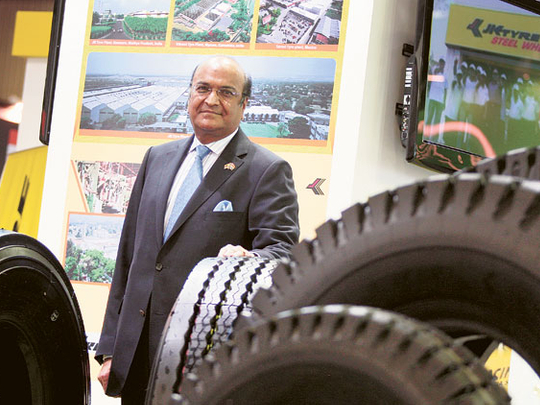
Dubai: JK Tyres, India's third largest tyre manufacturer, is looking for international acquisitions as part of its global expansion, a top official said.
"We are looking at international acquisitions in emerging markets including South East Asian countries, for strategic reasons," Dr Raghupati Singhania, Vice-Chairman and Managing Director of JK Tyre and Industries Ltd, told Gulf News in an interview.
"South East Asia provides a large supplier of rubber where labour costs are low. Besides, it is one of the fastest growing regions in the world, were demand for tyres is driven by the GDP growth of these countries."
About 73 per cent of the world's natural rubber is produced in South East Asia. Thailand produces 33 per cent while Indonesia produces 30 per cent followed by Malaysia with 10 per cent.
The company is investing $750 million (Dh2.8 billion) to raise capacity from 19 million tyres to 26 million and help the company become the world's 12th biggest tyre manufacturer within two years from its current 19th.
"Of this, we have already invested $250 million in Mexico and India, while $500 million more is in the pipeline," he said.
JK Tyres is part of a large conglomerate — JK Organisation — that operates in six major verticals such as paper, cement, agri-business, food and clothing. The group, with a turn-over of $1.5 billion (Dh5.5 billion), employs 50,000 people, including 9,000 working for the tyre industry spread across nine plants including six in India and three in Mexico.
Radial technology
The group, set up more than a century ago, started manufacturing tyres in 1977 while pioneering radial technology.
For a long time it focused on producing tyres for commercial vehicles — buses, trucks and pick-ups. However, it is currently expanding its passenger car tyre manufacturing that is expected to increase its market share.
"With the ongoing expansion, we expect our business to grow 20-25 per cent in Mexico," he said.
The company's exports to the Middle East are about $50 million (Dh183 million).
Singhania expects this to double in two years.
The Indian tyre industry accounts for approximately 5 per cent of global tyre demand, generating revenues of about Rs300 billion in 2011.
India produced 119 million tyres or 1.5 million tonnes in the 2010-2011 financial year.
On an average, nearly 60 per cent of the production is consumed by the replacement market while 25 per cent is sold to the original equipment manufacturing (OEM) market. Tyre exports turnover last year reached Rs36 billion. The origin of the Indian tyre industry dates back to 1926 when Dunlop Rubber Limited set up the first tyre company in West Bengal and soon after that the tyre giants MRF followed and set the ball rolling.
Currently, about 39 manufacturers share India's tyre market, while the top ten control the lion's share, according to the Automotive Tyre Manufacturers Association. "Higher interest rates and rising oil prices substantially increased the cost of vehicle ownership of fleet operators.
After the medium and heavy commercial vehicle segment, the passenger vehicle segment is the second largest contributor to revenues for the tyre industry, contributing nearly 16 per cent," said, Alok Deora, Equity Analyst at Sushil Finance.
Improve
"Demand is therefore likely to improve from the 2013 financial year onwards."
Industry insiders say there is a direct correlation between economic growth and mobility.
Passenger vehicle sales are expected to grow from 2.2 million in 2009 to 5.1 million in 2015 implying a CAGR of 15.0 per cent.
On the other hand commercial vehicle sales including small medium and heavy vehicles are expected to grow from 470,000 in 2009 to 1.42 million in 2015 implying a compound annual growth rate (CAGR) of 20.2 per cent.
Auto demand touched new peaks during 2010 after a slowdown witnessed in 2009.
However, with oil prices declining and slower economic growth rates in China and India could help stabilise demand and rubber prices. "Chinese consumption of rubber will be contained this year," Dr Singhania says.
"The Reserve Bank of India has overshot itself in terms of interest rates. That has hurt our economy and rupee has taken a big hit.
"So there should not be an increase in rubber prices and therefore I do not anticipate a jump in tyre prices."










